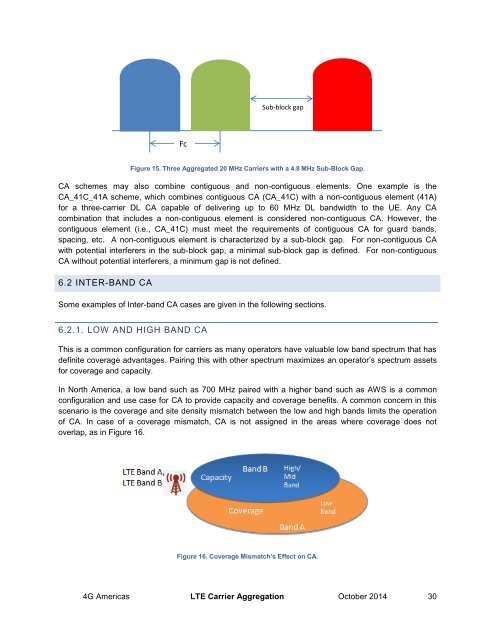4G Americas Carrier Aggregation_FINALv1 0 (2)
4G Americas Carrier Aggregation_FINALv1 0 (2)
4G Americas Carrier Aggregation_FINALv1 0 (2)
Create successful ePaper yourself
Turn your PDF publications into a flip-book with our unique Google optimized e-Paper software.
Sub-block gapFcFigure 15. Three Aggregated 20 MHz <strong>Carrier</strong>s with a 4.8 MHz Sub-Block Gap.CA schemes may also combine contiguous and non-contiguous elements. One example is theCA_41C_41A scheme, which combines contiguous CA (CA_41C) with a non-contiguous element (41A)for a three-carrier DL CA capable of delivering up to 60 MHz DL bandwidth to the UE. Any CAcombination that includes a non-contiguous element is considered non-contiguous CA. However, thecontiguous element (i.e., CA_41C) must meet the requirements of contiguous CA for guard bands,spacing, etc. A non-contiguous element is characterized by a sub-block gap. For non-contiguous CAwith potential interferers in the sub-block gap, a minimal sub-block gap is defined. For non-contiguousCA without potential interferers, a minimum gap is not defined.6.2 INTER-BAND CASome examples of Inter-band CA cases are given in the following sections.6.2.1. LOW AND HIGH BAND CAThis is a common configuration for carriers as many operators have valuable low band spectrum that hasdefinite coverage advantages. Pairing this with other spectrum maximizes an operator’s spectrum assetsfor coverage and capacity.In North America, a low band such as 700 MHz paired with a higher band such as AWS is a commonconfiguration and use case for CA to provide capacity and coverage benefits. A common concern in thisscenario is the coverage and site density mismatch between the low and high bands limits the operationof CA. In case of a coverage mismatch, CA is not assigned in the areas where coverage does notoverlap, as in Figure 16.Figure 16. Coverage Mismatch’s Effect on CA.<strong>4G</strong> <strong>Americas</strong> LTE <strong>Carrier</strong> <strong>Aggregation</strong> October 2014 30


